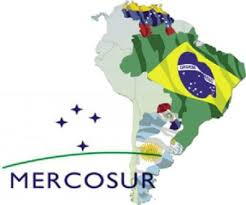
Dr Diego Acosta Arcarazo, Lecturer in European Law, Law School
Free movement of people in the European Union (EU) is currently under attack by certain political and media sectors across Europe, with proposals arising on how to limit its scope. At the same time, other regions in the world are adopting free movement regimes. This is important to highlight as it allows us to demonstrate that the EU’s free movement regime is not an anomaly as its opponents often argue. It also enables us to compare how different regions function in this area which can lead to ideas and proposals for refining legislation and policies. As such, current debates on the construction of a South American citizenship as well as the MERCOSUR Residence Agreement, effectively establishing an open border area in the region, deserve our attention in Europe.
MERCOSUR is a regional organisation created in 1991, now consisting of Brazil, Argentina, Paraguay, Venezuela and Uruguay, although Paraguay is currently suspended. Free movement was not one of its original objectives but it was introduced onto the agenda in the early 2000s to make it more appealing to regional citizens and in 2002 the MERCOSUR Residence Agreement was adopted. Implemented in 2009, the Agreement’s main objective focuses on the situation of intra-regional migrants and it has transformed the migration regime for South Americans. It provides that any national of a MERCOSUR or Associate Member State may reside and work for a period of two years in a host State. After two years, the temporary residence permit may be transformed into a permanent one if the person proves legitimate means of living for his or herself and any family members. It also lays down a number of rights including the right to work and equal treatment in working conditions, family reunion or access to education for children. All countries in South America (i.e. not just MERCOSUR countries) have ratified the agreement and apply it, with the exception of Venezuela where it is currently in discussion, and Surinam and Guyana where it is yet to be adopted.
 MERCOSUR’s Residence agreement differs from the EU’s free movement regime in various ways. For instance, in contrast to the EU, where there is an obligation to be working or to prove sufficient resources in order to be able to reside in another Member State for longer than 3 months, citizens in South America may reside for up to two years by simply providing an identification document and proof of a clean criminal record for the previous five years. However, under the MERCOSUR agreement the burden is on the individual to prove that they are not a threat to public policy or security by producing such a clean criminal record. In Europe, by contrast, the responsibility lies with the national authorities to demonstrate that the person endangers public policy or public security of the State.
MERCOSUR’s Residence agreement differs from the EU’s free movement regime in various ways. For instance, in contrast to the EU, where there is an obligation to be working or to prove sufficient resources in order to be able to reside in another Member State for longer than 3 months, citizens in South America may reside for up to two years by simply providing an identification document and proof of a clean criminal record for the previous five years. However, under the MERCOSUR agreement the burden is on the individual to prove that they are not a threat to public policy or security by producing such a clean criminal record. In Europe, by contrast, the responsibility lies with the national authorities to demonstrate that the person endangers public policy or public security of the State.
There are also conceptual and implementation differences. Free movement of people does not constitute a fundamental freedom in South America. It is rather the result of an international treaty, the MERCOSUR Residence Agreement, for which there are no coercive intra-regional mechanisms to ensure implementation or impose sanctions for violations. If disputes arise they are rather informally solved at the level of the MERCOSUR Migration Forum composed of government officials in charge of migration portfolios. This, in turn, leads to great variation regarding the implementation of the agreement, with some countries applying it without restrictions, e.g. Argentina or Brazil; others only implementing it for nationals of a reduced group of countries, e.g. Chile; and others still, such as Ecuador, imposing very high fees to obtain the residence permits (230 and 350 U.S. dollars for the temporary and permanent residence permits respectively). Finally, Uruguay implements it more generously and has recently adopted legislation by which nationals of MERCOSUR and Associate States will be able to directly obtain permanent rather than temporary residence, by simply proving their citizenship.
The MERCOSUR Residence agreement is one of the various ongoing measures being proposed and adopted in South America towards the establishment of a new regional citizenship by 2020. Another MERCOSUR proposal currently being discussed would, if approved, grant further free movement rights not only to regional citizens but also to third-country national residents. This would go well beyond the EU’s current regime and would materialize the vision to extend free movement to extra-regional migrants, which has been long defended in Europe by scholars, NGOs, think tanks and certain MEPs.
Finally, South America’s liberal migration discourse during the last 15 years, as represented by the 2013 Buenos Aires declaration calling on the human right to migration and the recognition of migrants as subjects of Law and the rejection of any attempt to criminalize irregular migration, makes scrutinising these developments worthwhile, because of the potential policy lessons which may emerge in both directions.
Further reading on this topic:
1. D. Acosta Arcarazo and F. Freier, ‘Turning the immigration policy paradox upside down? Populist liberalism and discursive gaps in South America’ (2014) International Migration Review.
2. D. Acosta Arcarazo and A. Geddes, ‘Transnational Diffusion or Different Models? Regional Approaches to Migration Governance in the European Union and MERCOSUR’ (2014) 16 European Journal of Migration and Law 19-44.
Dr Diego Acosta Arcarazo is a member of the research project Prospects for International Migration Governance (MIGPROSP). You can follow him on twitter @Dacostaarcarazo
A longer version of this post was published on 14th November at the blog EU law analsyis.

It’s a lesson for African regional integration schemes for moving ahead common market integration.